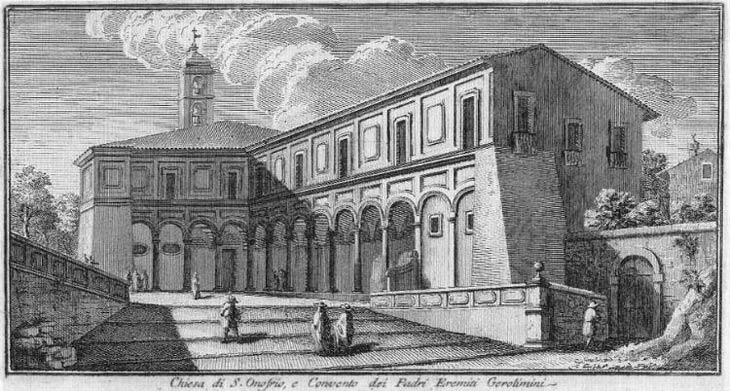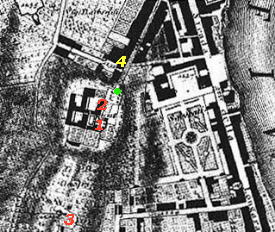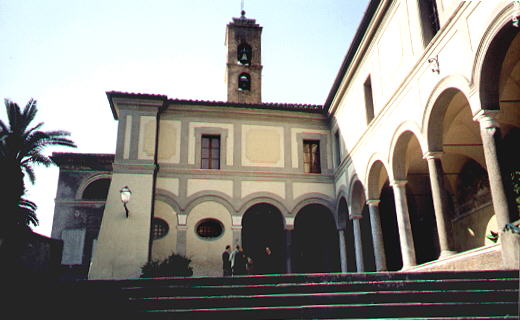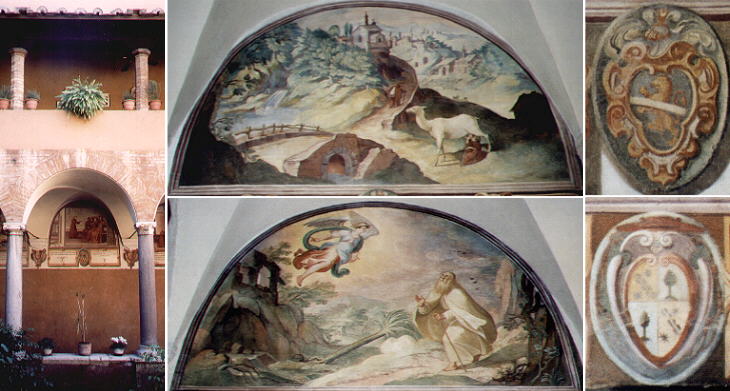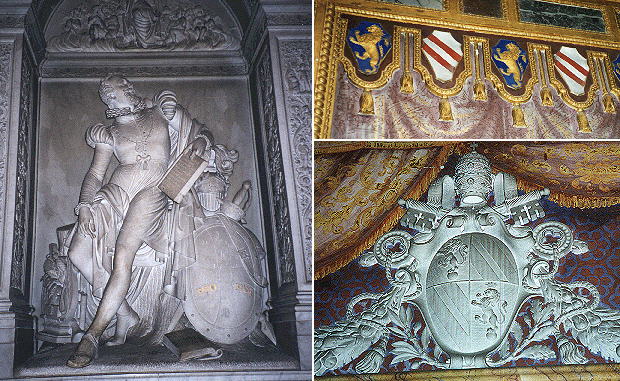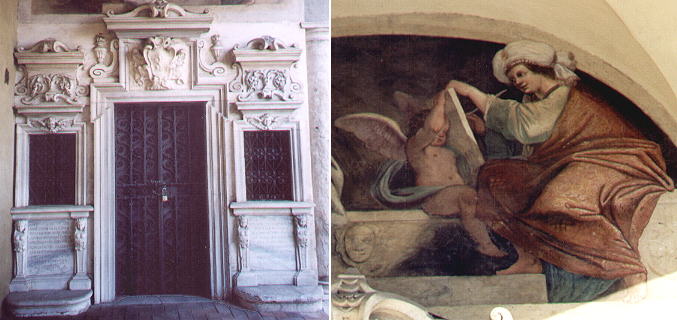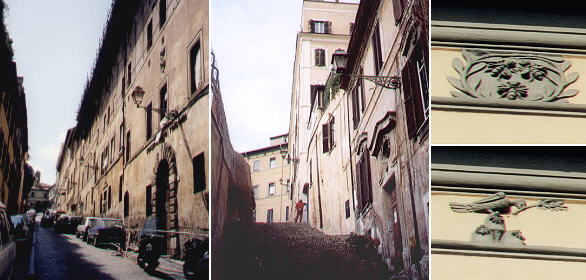

Chiesa e Convento di
S. Onofrio (Book
7) (Map
D2) (Day 6) (View D1) (Rione Trastevere)
In this page:
The plate by Giuseppe Vasi
Today's view
The cloister
The tomb of Torquato
Tasso
Cappella della Madonna del Rosario
Teatro di pii trattenimenti
Conservatorio del
Padre Bussi (Palazzo Giori)
The Plate (No. 123 - ii)
S. Onofrio is built on the slope of the Janiculum and commands a
nice view over Rome. The view is taken from the green dot in the small 1748 map here below which shows:
1) S. Onofrio;
2) Cappella della Madonna del Rosario; 3) Teatro di pii trattenimenti; 4) Conservatorio del Padre Bussi.
Today
The church and the friary are untouched and a little garden protects
them from modern life. Under the arches in the lunettes there are several interesting frescoes.
The Cloister
In the little cloister the life of the Egyptian hermit Honophrius
is narrated in an extremely simple manner. Each lunette is explained both in
Latin and Italian. In the lunettes above we are told that Honophrius for three years
lived on a white doe's milk and that his death was announced by an angel. Each lunette bears the coat of arms of one
of the sponsors who paid for the decoration. Among them Cardinal Sfondrati who later became
Pope Gregorius XIV for a few months.
The tomb of Torquato
Tasso
Torquato Tasso lived for many years in this monastery and here he
died in 1595 on the day he was to receive the laurels on the Capitol.
This chapel inside the church was built by Pius IX as the decoration of
the walls and the coat of arms tell us.
Madonna del
Rosario
The last two arches of the porch were closed in at the beginning of the XVIIth century to obtain
a chapel belonging to the Vaini family. The entrance has a fine marble decoration. Above it there is a painting by
Agostino Tassi portraying two Sybils (for a while the detail above was used as the guestbook icon of this web site).
Teatro
di pii trattenimenti
Torquato Tasso used to rest under an oak near S. Onofrio. The little summer
open air theatre near that tree is now named after him (Teatro Alla Quercia del Tasso). The oak was struck by lightning in 1843 and today a wall supports its trunk
(you can have a closer look at the sarcophagus by clicking here).
The reference to
pious entertainments (pii trattenimenti) is due to the fact that S. Filippo
Neri used it to teach to his pupils.
Conservatorio
del
Padre
Bussi
The steep ascent to S. Onofrio is flanked with a series of tall buildings
named after the Torlonia family. At the top of the street (and of steps near Palazzo Salviati) there is the building mentioned
by Vasi in his Grand View of Rome (No. 367) where father Alessandro Bussi run a charity. It is known as Palazzo Giori after Angelo Giori who
added to his coat of arms the bees of Urbanus VIII when this pope appointed him cardinal.
Excerpts from Giuseppe Vasi 1761 Itinerary related to this page:
Conservatorio del P. Bussi
Dal P. Alessandro Bussi prete della Congregazione dell'oratorio con altri preti ebbe
principio questo conservatorio l'anno 1703. in una casa presso il consolato de' Fiorentini,
ad effetto di collocarvi alcune povere donne, che vogliono lasciare il peccato.
Dipoi concorrendovi alcune persone pie con grosse limosine nel 1740. quì furono
trasportate nel palazzo del Card. Giori, ed appresso la
Chiesa e Convento di s. Onofrio
Sull'ultima punta del monte Gianicolo verso ponente, e sovrastante alla valle Vaticana,
si vede quella chiesa eretta con il convento da Eugenio IV. e poi terminata dalla famiglia
Romana de' Cupis. Sebbene essa sia piccola, e di forma gotica, pure è ornata di belle pitture,
e memorie riguardevoli. Sulla porta, della chiesa, evvi un immagine della ss. Vergine
dipinta dal Domenichino, e altre pitture nel portico laterale. Le pitture nella prima
cappella a destra sono antiche; la ss. Vergine di Loreto nella seconda è opera di Annibale
Caracci il resto però è di Gio. Batista Ricci; Le pitture nell'altare maggiore, dalla
cornice in su, sono di Bernardino Pintorecchio, e quelle dalla cornice in giù, di Baldassare
Peruzzi. Il B. Pietro da Pisa nella cappella, che segue è del Calandrucci Palermitano,
ed il s. Girolamo nell'ultima è di Michelangelo Ricciolini Romano; e le altre pitture sono
di Pietro Nelli. Inoltre vi sono de' sepolcri di marmo, fra' quali evvi quello di Guglielmo
Barclai letterato Inglese, di Tarquinio Tasso, e di Alessandro Guidi celebri poeti Italiani.
I Religiosi, che ufiziano quella chiesa, ebbero principio l'anno 1388. dal B.
Niccolò da Pozzolo, il quale quì con alcuni compagni si pose a vivere sotto la protezione
di s. Girolamo, e vi stettero da Romiti fino all'anno 1568. allorchè s. Pio V. obbligolli
alla professione de' tre voti sotto la regola di s. Agostino; e però Sisto V. pose la
chiesa nel numero de' Titoli Cardinalizi, e vi aperse incontro la strada. Nel chiostro del
convento vi dipinse Vespasiano Strada alcuni fatti di s. Onofrio, e Leonardo da Vinci
un' immagine della ss. Vergine; ma la Natività del Signore nella cappelletta ornata
di marmi è del Ballano.
Teatro di pii trattenimenti
San Filippo Neri per allettare la gioventù alla parola di Dio, e altresi per allontanarla
dalle lusinghe del secolo, soleva nell'alto del giardino di quello convento andare a spasso
con li suoi penitenti, e con bella grazia vi introdusse alcune conferenze spirituali, con
altri devoti trattenimenti. Perciò i Preti dell' Oratorio ad imitazione del loro santo
Fondatore seguitano in ogni festa di precetto dopo il vespro, principiando dal secondo
giorno di Pasqua di Resurrezione fino alla festa di s. Pietro Apostolo, a venirvi con gran
concorso di uomini devoti, e vi fanno de' sermoni accompagnati con pii trattenimenti. A tal
fine hanno eretto nel medesimo luogo, che frequentava s. Filippo tutto il comodo con sedili
in forma di teatro, inalberando però sulla cima il segno della s. Croce.
|
Next plate in Book 7: Chiesa di S. Maria in Traspontina
Next step in Day 6 itinerary: Palazzo Lanti

Go
to  or to Book
7 or to the Plan
of my site or to my Home
Page on Baroque Rome or to my Home Page on Rome
in the footsteps of an XVIIIth century traveller.
or to Book
7 or to the Plan
of my site or to my Home
Page on Baroque Rome or to my Home Page on Rome
in the footsteps of an XVIIIth century traveller.
|


